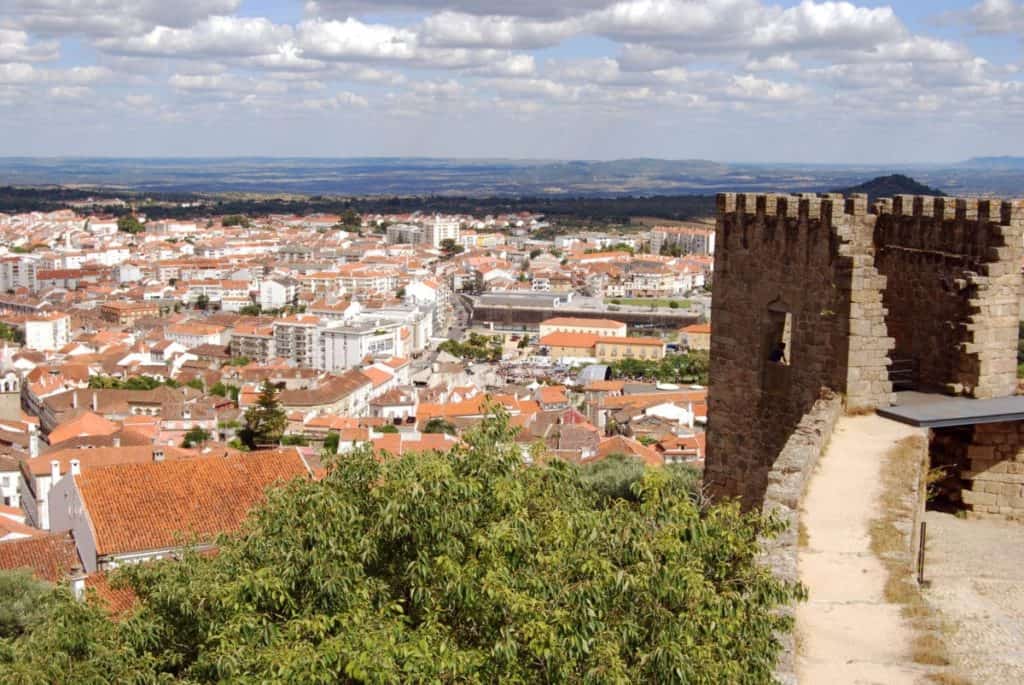Summary
- Jardim do Paço
- Museu Francisco Tavares Proença Júnior
- Parque da Cidade
- Museu de Arte Sacra
- Old Town
- Castelo e Muralhas
- Museu Cargaleiro
- Miradouro de São Gens
- Centro de Cultura Contemporânea de Castelo Branco
- Cruzeiro de São João
- Piscina Praia
- River Beaches
- Portas de Ródão
- Tejo International Natural Park
- Local Gastronomy
A frontier town of Castelo Branco, founded at the base of a Templar castle in the 13th century, has endured centuries of conflict, facing multiple attacks during the 17th and 18th centuries. Once serving as the seat of a diocese, the town features significant attractions such as the bishops’ palace and its expansive gardens.
The Baroque garden boasts elegant fountains, intricate tilework, and statues depicting apostles, kings, and mythical beasts. The palace also serves as a museum, exhibiting local craftsmanship, particularly the celebrated colcha quilts adorned with elaborate silk embroidery, a tradition in Castelo Branco since the 1600s. Flowing to the south is the Tagus River, which carves through a ridge in the mountain range at Ródão, creating a stunning canyon that provides a habitat for various birds of prey.
Let us uncover the premier activities to experience in Castelo Branco:
1. Jardim do Paço

The garden adjacent to Castelo Branco’s episcopal palace stands as an essential sight in the city.
Developed in the 18th century by Bishop João de Mendonça, this garden features a layout of boxwood hedges, accompanied by fountains and statues representing both religious figures and lions, while the walls display figurative tile panels.
Statues guarding the balustrade celebrate the kings who reigned in Portugal during this timeframe.
Moreover, one may find interesting details regarding the unpopular Spanish kings who governed Portugal during the Philippine era, as their statues are notably smaller than those of the Portuguese monarchs.
2. Museu Francisco Tavares Proença Júnior

The adjoining episcopal palace, dating back to the late 16th century, provides a comprehensive introduction to the city’s history and its customs.
Castelo Branco is renowned for its silk embroidery, reflected in numerous linen quilts (colchas) featuring delicate and vibrant patterns, crafted by artisans over several centuries.
The museum includes a lapidary in the vaulted basement housing inscribed stones from the Iron Age and the Roman period, alongside Flemish tapestries from the 16th century and portraits of the bishops who resided in this establishment.
3. Parque da Cidade

Adjacent to the episcopal palace is another green space that formerly belonged to the Bishops of Castelo Branco.
The areas closest to the palace served as their kitchen garden, with the town still cultivating herbs in square plots, a nod to the park’s historical usage.
Furthermore, this park offers a refined ambiance for relaxation, bordered by the Covento da Graça and the palace, adorned with fountains, reflecting pools, and a sizable circular pergola.
4. Museu de Arte Sacra

Located merely a stone’s throw from the episcopal palace and bordering the park, the Covento da Graça is another significant site in Castelo Branco.
This stunning Mannerist complex from the 16th century includes the sacred art museum, housed in the convent’s treasury.
Among the collection are statues from the convent’s early days, depicting St. Matthew, St. John the Baptist with a poor man, a Virgin with Child, and a statue of Isabella of Portugal, who was Holy Roman Empress from 1530 to 1539.
5. Old Town

The medieval core of Castelo Branco comprises a captivating maze of narrow streets lined with whitewashed houses in varying states of restoration.
One notable thoroughfare is the steep Rua dos Peleteiros, which harkens back to the historical trades once prevalent here.
The route leads to charming squares such as the Praça de Camões, arguably the most picturesque in the city, featuring the former town hall adorned with a carved coat of arms and an elegant arcade.
Across from this is the Solar dos Motas, a 17th-century mansion originally for the Guilherme da Cunha family, now serving as a municipal building.
6. Castelo e Muralhas

Continuing up the Rua dos Peleteiros leads to the medieval castle that lends Castelo Branco its name.
This location represents the city’s highest point, with the silhouette of the singular tower visible from afar.
This fortification, built by the Templars in the early 13th century, suffered significant damage during the Portuguese Restoration War in the 17th century, as well as during the War of the Spanish Succession and the Napoleonic Peninsular Wars.
By the 1800s, much of its stone was repurposed for construction in the city.
Nevertheless, visitors can still grasp the castle’s former grandeur and appreciate the breathtaking views it affords over the city.
7. Museu Cargaleiro

The 18th-century Solar dos Cavaleiros, an elegant mansion in the historic center of Castelo Branco, houses the Museu Cargaleiro.
This facility, which incorporates a modern wing, is dedicated to the work of Manuel Cargaleiro, a celebrated artist with a distinguished career that spans nearly 80 years.
Born in a nearby village in 1927, Cargaleiro is best recognized for his glazed tiles, crafted in traditional techniques but showcasing modern, abstract designs.
The museum also features sections devoted to his lithographs, traditional paintings, and exquisite ceramic bowls.
8. Miradouro de São Gens

Just a short walk from the castle brings you to another viewpoint, thoughtfully landscaped in the early 1940s.
It merits the effort to reach as much as the castle itself, thanks to the charming little garden situated here.
The belvedere is accessible via a staircase flanked by trees that create a natural canopy overhead.
In the garden, a fountain and walls decorated with blue tiles enhance the tranquil atmosphere.
From this vantage point, the view encompasses the lush hedges of the Jardim do Paço and the surrounding olive groves that grace the countryside around the city.
9. Centro de Cultura Contemporânea de Castelo Branco

In 2013, Castelo Branco inaugurated a contemporary cultural center, offering a fresh visual identity for the city.
This impressive structure features expansive cantilevered sections that extend over the ramps leading to both the front and rear.
The center includes an auditorium accommodating 275 attendees, designed with top-notch acoustics by the renowned Catalan expert Higini Arau.
Performances hosted in this venue predominantly feature classical soloists and small ensembles.
If you are simply interested in viewing the architecture, the center also hosts temporary art exhibitions across its two galleries, showcasing regional painting, photography, sculpture, and various installations.
10. Cruzeiro de São João

Situated in Largo de São João is a granite cross erected in front of a church in the early 16th century.
Despite the church’s absence, the cross persists as a national monument, celebrated for its exceptional Manueline design.
Surrounding the cross are benches, inviting visitors to pause and admire the intricate details.
The spiral column exemplifies the Manueline style, supporting a decorative bed with botanical motifs that cradles the cross.
Originally, the octagonal base featured chained figures symbolizing temptation.
11. Piscina Praia

Summer can be intense in this landlocked region of Portugal, with temperatures often soaring above 30°C in June, July, and August.
This tranquil water park on the outskirts of town provides a refreshing escape, featuring inviting turquoise pools and verdant spaces.
Unlike typical water parks, Piscina Praia emphasizes relaxation over slides and flumes, being ideal for unwinding for a few hours.
The centerpiece is the largest pool in Portugal, spanning an expansive 8 hectares.
Most of this pool maintains a depth of only 50 cm, never exceeding 160 cm, making it suitable for younger children.
It is equipped with various games and climbing structures, while activities are organized to keep the younger visitors engaged.
12. River Beaches

Another refreshing option to escape the summer heat is visiting one of the river beaches (praias fluviais) in the area.
These picturesque spots vary in form, most of which are set against stunning natural backdrops.
Both Sesmo and Almaceda resemble outdoor swimming pools, having been formed by locks in the river.
These bodies of water lack a current, creating a natural swimming area.
Taberna Seca is conveniently located just ten kilometers west of the city along a bend in the River Ocreza.
This idyllic natural setting is embraced by the towering cliffs of the river valley.
13. Portas de Ródão

Approximately 20 minutes south of Castelo Branco, the Tagus River has hewn a spectacular canyon in the Serra das Talhadas mountains, with towering walls reaching 170 meters high.
These monumental formations resemble enormous gates, hence the name “Portas,” and this site has been designated as a Portuguese natural monument.
Approaching from Castelo Branco, one will arrive at the north “gate,” topped with a modest tower claimed to be the remnant of a castle belonging to the 6th-century Visigothic King Wamba.
The serenity of the gates contrasts with their dramatic presence, and if you linger, you may spot red kites, griffon vultures, and black storks soaring in the canyon.
14. Tejo International Natural Park

Castelo Branco lies just 10 kilometers from the boundary of this natural reserve, which crosses into Spain and encompasses the stunning banks of the Tagus River.
If tranquility is what you seek, this is the least populated region in Portugal, characterized by awe-inspiring landscapes that are starkly barren in some areas while flourishing with natural wealth in others.
The park is home to cork and holm oaks, aromatic herbs such as rosemary, and moorlands adorned with vibrant heather.
Wildlife including deer, foxes, and wild boar roam freely, alongside Neolithic and Roman remnants, alongside the haunting ruins of the abandoned village of Alares from the 1920s.
15. Local Gastronomy

Castelo Branco is distinguished for its premium olive oil and honey, both of which make ideal gifts to take home.
Traditional dishes from this rural expanse of Portugal are simple yet hearty, emphasizing local produce over imported goods.
For an authentic dining experience, consider trying empadas de Castelo Branco, a pie filled with pork and onions, cheese soup, roast lamb, roast partridge, goat stuffed with bacon and herbs, or fried liver seasoned with onion, tomato, and paprika.
Additionally, the town boasts several delectable desserts, including rice pudding flavored with cinnamon, tigelada resembling crème brûlée, and honey and almond cookies known as broas de mel.





